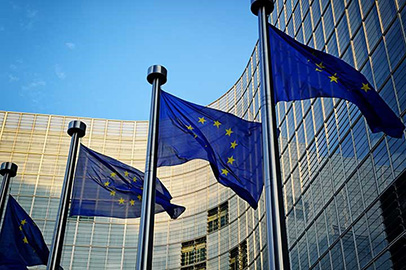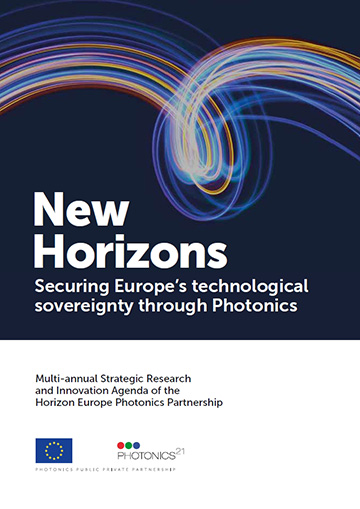
[Image: Getty Images]
The European Photonics Public-Private Partnership (PPP), managed by the technology platform Photonics21, has published an updated version of the organization’s roadmap for 2021–27—the period covered by the European Union’s new framework program for research funding, Horizon Europe. The new roadmap document comes roughly a year and three-quarters after the release of its most recent predecessor, Europe’s Age of Light, which aimed to influence and help shape the Horizon Europe approach to investing in photonics research.
In overall design and structure, the early-2019 and late-2020 roadmap documents are quite similar. But even a superficial reading highlights the immense changes wrought in the past year, both in Horizon Europe’s overall ambitions and in the EU’s funding emphases. In particular, though the pandemic is mentioned only seven times by name, COVID–19 and its impact on European research funding, as well as the European Green Deal and issues of European “digital and technological sovereignty,” are new themes that permeate the revised roadmap.
Uncertain status
The March 2019 version of the Photonics21 strategic roadmap was in large part an effort to make the case for photonics as a key technology in the Horizon Europe framework, at a time when the discipline’s status in the framework was uncertain.
The 2013 creation of the Photonics PPP reflected the privileged status of photonics as one of six Key Enabling Technologies (KETs) under Horizon Europe’s predecessor, Horizon 2020, the EU funding framework program covering the years from 2014 to 2020. The PPP subsequently achieved considerable success, matching the hundreds of millions of euros in EC-level Horizon 2020 investment with 4.3 times as many euros from industry through 2018, according to Photonics21.
As plans for Horizon Europe framework started to take shape in late 2018, however, it became clear that the EU funding program for 2021–2027 would rely less than its predecessor had on vehicles such as KET designations and technology-specific PPPs, and more on interdisciplinary, mission-driven theme areas such as digital technology, health, climate, and food and natural resources. Further, photonics was not included among the original technological priorities for the cluster of digital-technology research activities embodied in the original Horizon Europe plan.
The omission triggered an intense lobbying campaign in the European photonics community that included a blistering December 2018 open letter from Nobel Laureates Theodor Hänsch, Stefan Hell and Gérard Mourou, as well as the March 2019 strategic roadmap from Photonics21.
Horizon Europe: Up, down, sideways

The EU research funding situation has become, if anything, more fraught since the beginning of coronavirus-haunted 2020. One key development has been a dramatic scaling-back of ambitions for the Horizon Europe plan itself, in the face of other demands to fund economic recovery from the pandemic.
Hopes had been high within the research community for a substantial expansion of the Horizon Europe pot over Horizon 2020 levels, with a provisional budget as high as €107 billion proposed for the seven-year program in mid-2019. One year later, in the shadow of the pandemic, the EU’s heads of state, in a July 2020 budget summit, voted to slash the planned Horizon Europe budget to only €80.9 billion (in 2018 Euros).
Since the summit, the European Parliament has worked to beef up the Horizon Europe allocation, and on 11 December—reportedly after a 14-hour marathon horse-trading session between Parliament and the European Council—announced a final budget of €95.5 billion (in current euros) for the program. Interestingly, one winner in the final budget round was funding for basic/fundamental research, which many Parliament members had feared was being underfunded in the big-theme-driven Horizon Europe plan. In particular, the European Research Council (ERC), the EU’s main basic-science agency, received an extra €1.1 billion allocation under the revised plan.
Looking at “New Horizons”
Amid the twists and turns for Horizon Europe, Photonics21 has continued its efforts to make the case for a new Photonics PPP within the framework program. In May 2020, in response to a late-2019 call from the European Commission, European photonics advocates submitted a draft proposal for a new European Partnership for Photonics, under the title “Photonics for a Healthy, Green & Digital Future.” (A reportedly tepid response to the proposal, and the prospect that funding for a new Photonics PPP might actually be less than the allocation under Horizon 2020, triggered another irate open letter from the Laureates in October 2020.)

[Image: Photonics21]
Following on from the new PPP proposal, the just-released updated Photonics21 roadmap—title New Horizons: Securing Europe’s Technological Sovereignty Through Photonics—represents an acknowledgment of the continent’s new realities in the wake of COVID–19. In particular, the document stresses the key role of photonics in enabling the goals of the “NextGenerationEU” agenda outlined in the September state-of-the-EU address by EC president Ursula von der Leyen.
Three areas receive particular attention in the revised Photonics21 roadmap:
“Digital sovereignty” for Europe. Perhaps most interesting, and embodied in the very title of the report, is a new stress in the revised roadmap on the role of photonics in “empowering a stronger, more innovative, more sovereign and more resilient European economy.” This goal—while always present in the background of Horizon Europe—has become more important, the report suggests, amid the dislocations of COVID–19, which have highlighted the essential role of digital infrastructure in communications, industrial strategy, emerging transformations driven by artificial intelligence, and “strategic value chains.”
Climate. The European Green Deal and Europe’s “green transition” feature prominently in the updated roadmap, and especially in a new chapter on “Climate, mobility and energy” that highlights the role of photonics to “revolutionize energy generation and energy conservation and as such,” and the importance of photonic sensing technologies to keep tabs on climate and pollution.
Health. A new phrase “smart health,” crops up at a number of points in the updated roadmap—a reflection of the identification of this area, and its empowerment of personalized medicine and cutting-edge health care, as one of six “strategic value chains” in a late 2019 EC report.
The roadmap report can be downloaded at the Photonics21 website.
